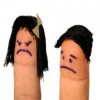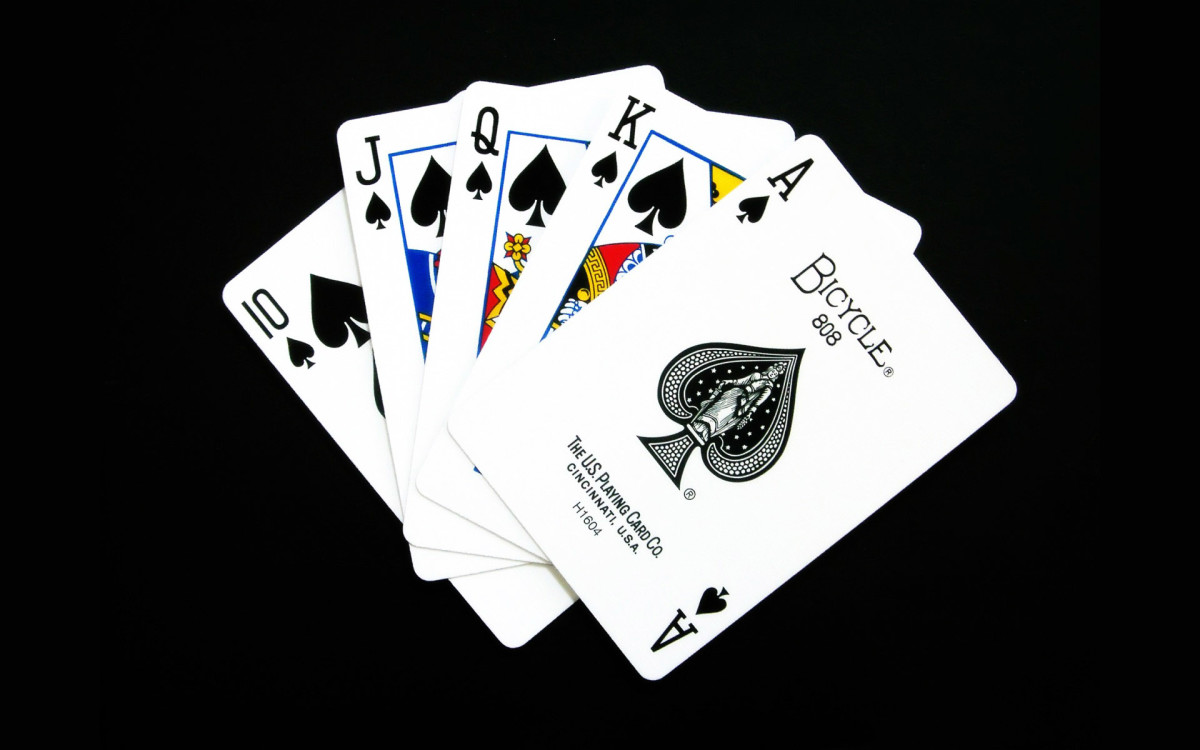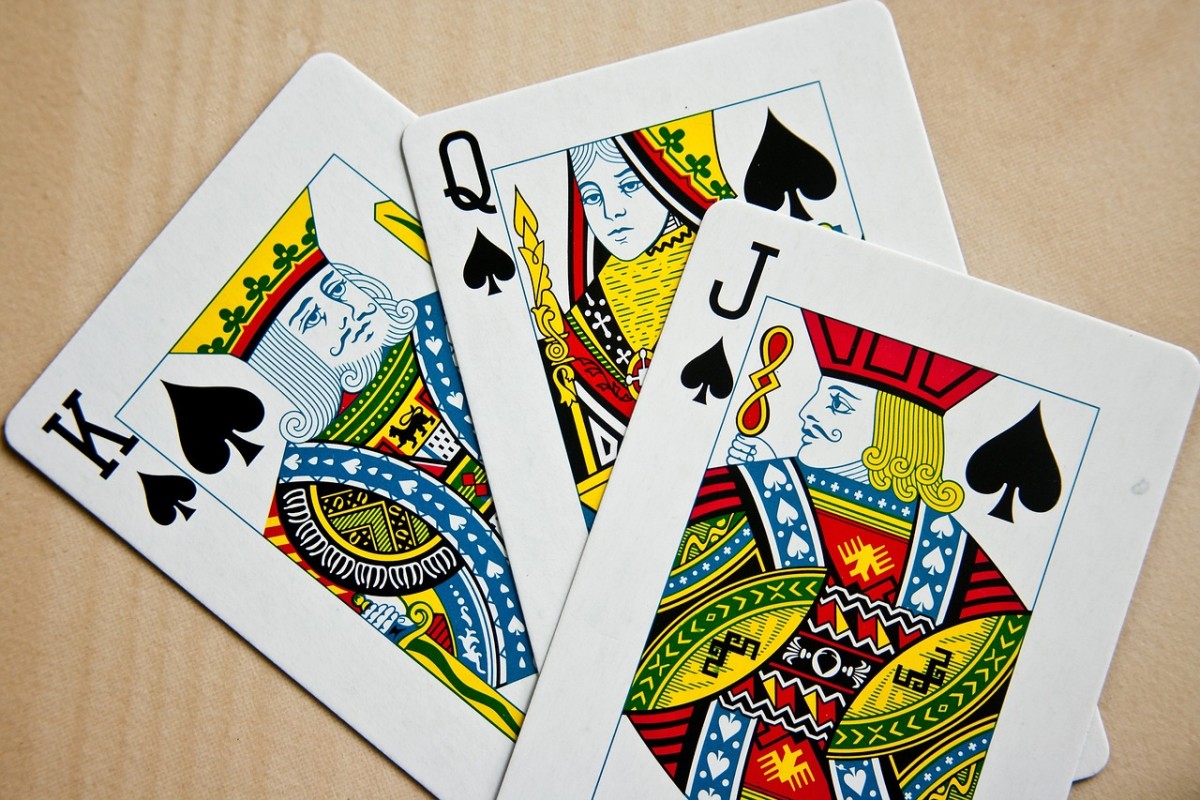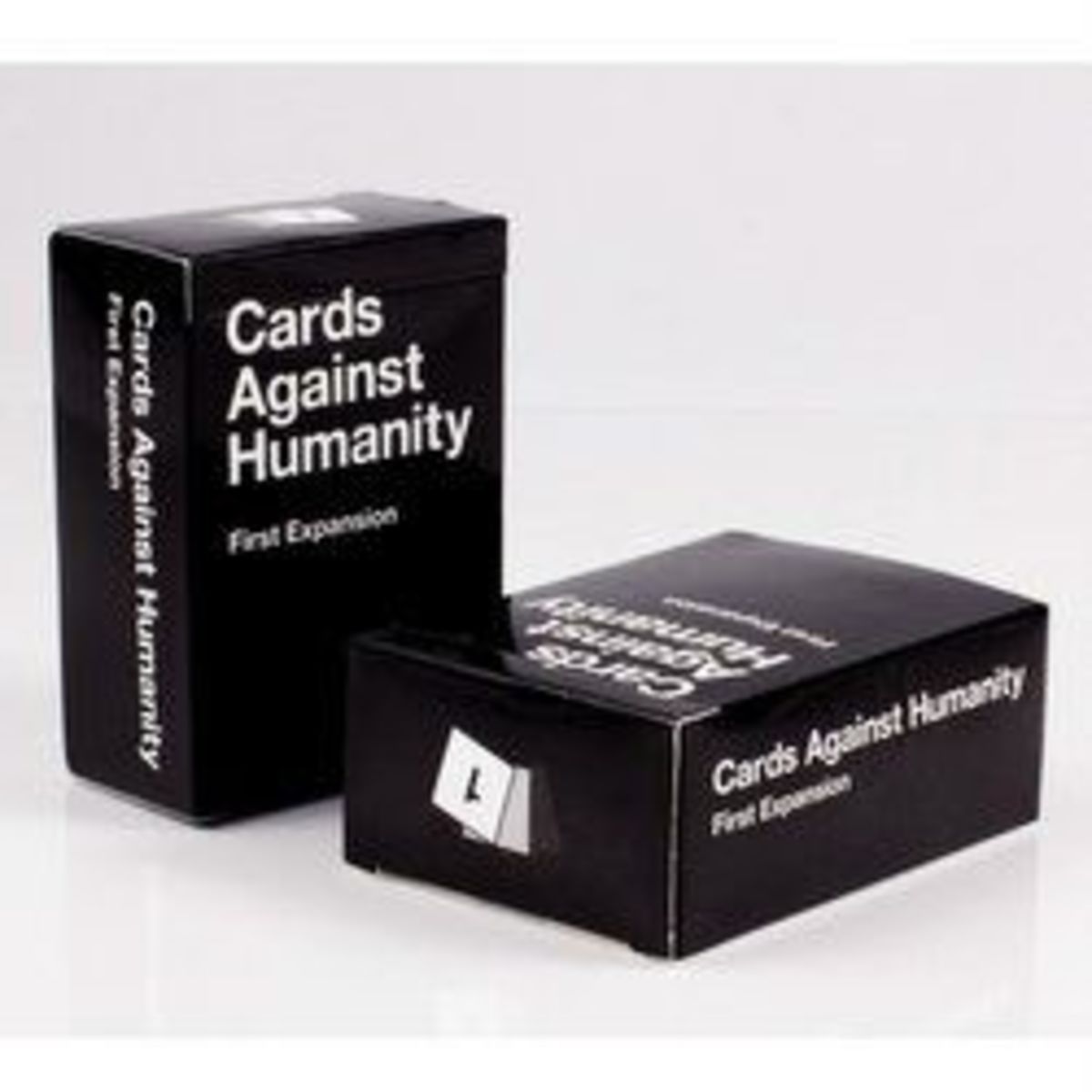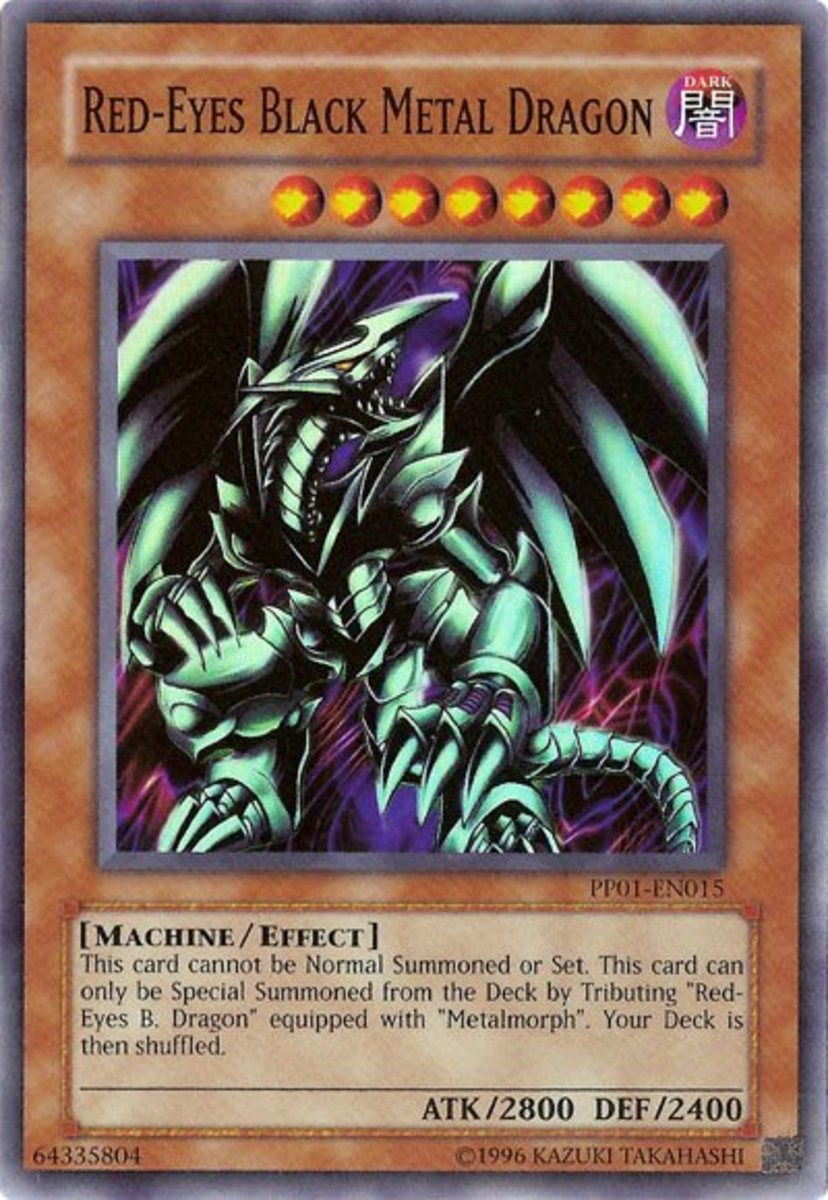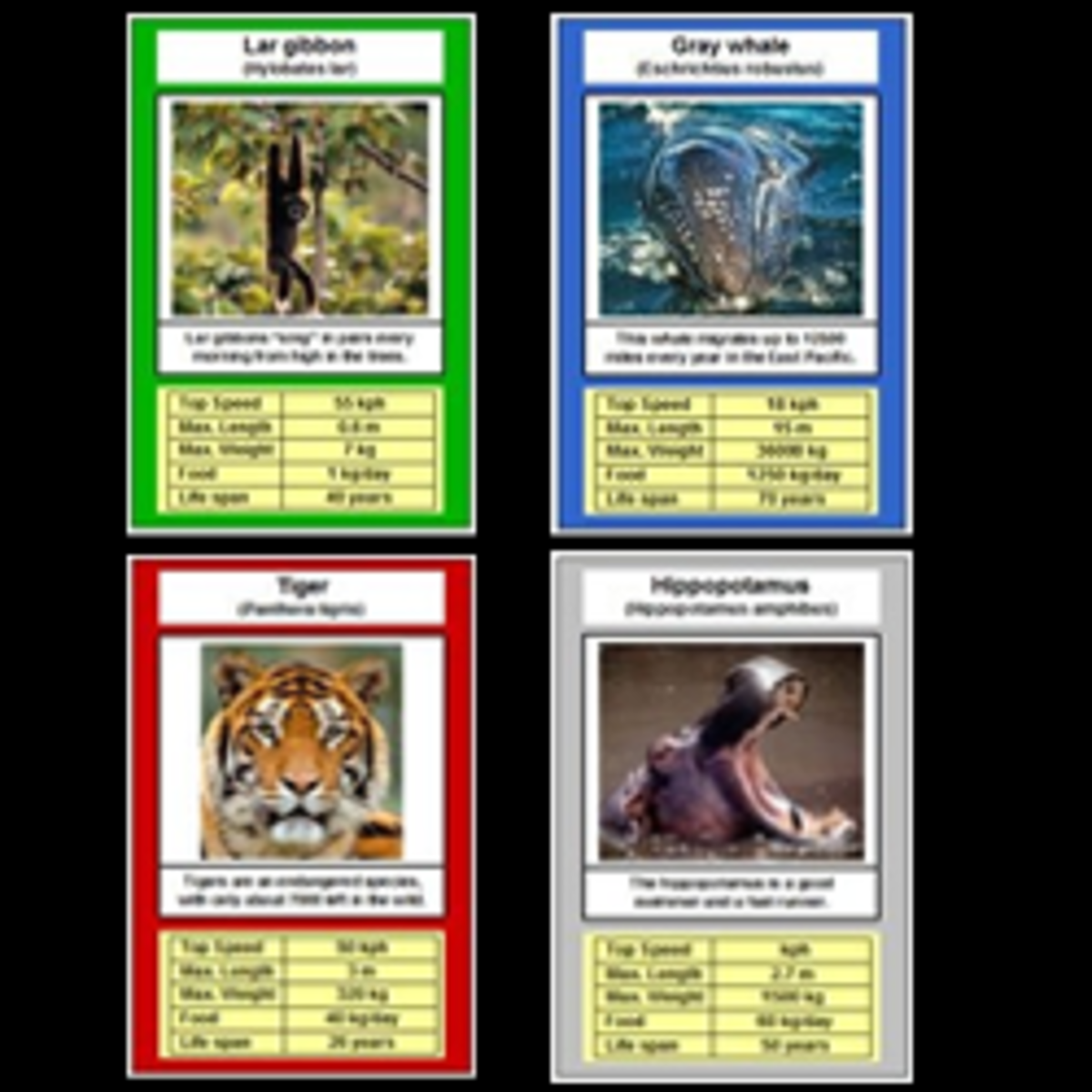Playing Cards
Playing cards are small layered-paper devices, generally rectangular, bearing suit marks and numerals on the face side and colorful designs on the back. Used in the playing of numerous games, a standard 52-card deck, or pack, such as for poker or bridge, consists of four 13-card suits called spades, hearts, diamonds, and clubs. Each suit contains three court or face cards (king, queen, and jack) and numeral cards from 1 (ace) to 10. The extra card, called the joker, became a part of the decks used in the United States in 1872. The joker is used as an extra or "wild" card in several American card games.
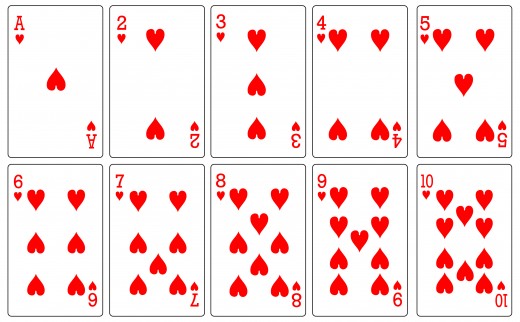
Evolution of the Deck
There is no written record that playing cards were in use until about the 12th century in the Orient, and little is known of their origin and intent. Some historians contend that cards evolved from chess, which emerged from a game played with pebbles by shepherds of western Asia. Others believe that playing cards evolved from divining rods or arrows that were used for conjuring and divination. Communication with the gods was obtained by casting the rods, marked with four different symbols, upon a central altar; the priests interpreted the commands of the gods according to the direction in which the rods fell. Whatever the origin of playing cards (Oriental, Egyptian, or Arabic) they found their way into European countries in the 12th century, perhaps carried there by traveling merchants, professional soldiers, or wandering tribes of Gypsies.
Early European cards were called Tarots (tablets of fate), or tarocchi. These were picture cards used for fortune-telling or instruction. The earliest such cards are the rare Tarocchi di Mantegna, engraved by the artist Mantegna in Lombardy in 1470. This 50-card pack has five groups of 10 cards each, bearing allegorical or mythological subjects representing the different states of life: as the Muses, the virtues, the planets, the liberal arts, and the sciences. These handsome pictures are now ascribed to Botticelli and Baldini, and the Florentine school of painting is evidenced in their design.
From the tarots of Mantegna evolved the 78-card Venetian tarots consisting of four suits of 14 cards each. Each suit has 4 coat (court) cards (king, queen, cavalier, and valet) and 10 numeral cards (1 to 10) bearing suits of swords, cups, money, and batons. In addition, the tarot pack includes 22 numbered atouts (high cards or trumps) with various meanings, bearing such symbols as the sun, the pope, justice, and death (the 13th card). The 22d card, which is unnumbered, is il motto (the fool), precursor to the modern joker.
In the 15th century this 78-card Venetian pack was increased to 97 cards to form the Florentine minchiate deck. The 19 atouts added were 3 virtues, 4 elements, and 12 signs of the zodiac. The later Bologna tarots, or tarocchino, reduced the Venetian pack to 62 cards by the elimination of the 2, 3, 4, and 5 of each suit. All three forms of tarots (the original Venetian, Florentine minchiate, and Bolognese tarocchino) are still in use in Italy.
Many shorter decks evolved from the original 78-card tarot pack. Trappola contained 36 cards (as a result of discarding the atouts, queens, 3's, 4's, 5's, and 6's) until the 18th century, when it was further cut to 32 cards with the elimination of the aces. The French game of piquet also had 36 cards after the dropping of the atouts, knights, and the 2, 3, 4, and 5 of each suit. The modern piquet pack has 32 cards, the 6 of each suit having been discarded in the 1700's. The Spanish hombre pack contains 40 cards: reyes (kings), caballeros (knights), sotas (knaves), and numeral cards 1 through 7.
Card Manufacture
Earliest European playing cards were handmade and beautifully painted, but because of their exorbitant cost they were the prerogative of only the wealthy. It was not until the invention of printing that playing cards were brought within the reach of the common people.
During the 15th century cards were printed from wood blocks, a form of printing first used by German "kartenmachers" (card makers) of Ulm, Nuremberg, and Augsburg, whose cards were exported to many countries. An old Ulm chronicle (about 1397) states: "Playing cards were sent in small casks into Italy, Sicily, and also over the sea, and bartered for spices and other wares." After complaints by
Italian artists that their craft was suffering because of excessive importation of cards, an order of the magistracy of Venice in 1441 forbade such practice under heavy penalty. An English petition in 1463 also forbade importation of cards because of similar difficulties.
Progress in card manufacture accelerated after the invention of the printing press, and the slow methods of hand coloring and wood blocking were replaced in the 16th century by copperplate engraving. The revolutionary process of color reproduction known as lithography was first used in the early 1800's to produce many beautiful series of German, Italian, and French cards. Today the photoengraving process used in the manufacture of cards has created an enormous increase in an industry that has had a tremendous influence on the Me and history of peoples everywhere.
Court-Card Design
Like other forms of art, the design of the court cards reflected the various whims of artists. Early card makers soon cast aside religious themes for the labors and merriment of the everyday scene. When playing cards were first separated from the original tarot into suits, full-length court figures portrayed various rulers. In some early Italian and Spanish packs, the 4 kings represented the four great world monarchies of the Middle Ages; mounted knights (or cabatteros) were used in place of the queens, which were still prominent in the French packs. Artists altered the court cards to resemble important rulers or nobility of the day; names, costumes, and weapons were also changed.
During the reign of Henry III of France, costumes reflected the extravagant fashions of the era. When Henry IV of Navarre mounted the throne, card costumes and names were immediately altered. In a pack of engraved English cards of 1780, the kings represented the flourishing monarchies of Britain, France, Spain, and Prussia. During the French Revolution the playing card "royal family" was banished from the pack because of the prevailing antagonism toward nobility, being replaced by philosophers and other important personages. However, by 1813 the card royalty had reappeared, and it has remained on face cards since that time.
Back Decoration. With the exception of the foldover woodcuts of the Italian tarots, which carried simple wood-block designs of a figure, flower, or coat of arms, early playing cards had plain uncolored backs. Simple uncomplicated patterns appeared in the early 1800's, but back decoration had its first artistic development under Owen Jones, artist for Thomas de la Rue, London card makers, about 1860. (Jones' book of original designs is retained in the Cincinnati Art Museum.) By the end of the 19th century back design had become an important phase of the playing card industry, and drastic changes were avoided to avert suspicion of a "marked" deck.
Suit Marks. Suit marks likewise passed through many changes in form, number, arrangement, and decoration. Early Chinese cards used suits of coins, strings of coins, myriads, and tens of myriads, resembling the values of Chinese paper money. An old Oriental circular pack contained 10 suits of 12 cards each, emblematic of the ten avatars (incarnations) of the Hindu deity Vishnu. The suits included were such as fish, lions, hogs, tortoises, serpents, dwarfs, apes, dragons, shells, men-horse, and wild boars. The four emblems of the earliest Italian tarots—swords, cups, rings, and batons—were the emblems held in the four hands of the two-headed Indian deity Ardhanari. These were symbolic of the four chief castes of men on the banks of the Ganges and Nile rivers. The suit of swords denoted the kings or soldiers; cups symbolized the church; rings (and coins) signified the merchants; batons (and wands) were emblematic of agriculture. The first known German cards of Stuttgart (1440) were a hunting series with suit marks of dogs, stags, ducks, and falcons. Conventional German suit marks were hawks (or bells) for the nobles, hearts for the clergy, leaves for the citizenry, and acorns for peasants.
Card makers of France simplified the shapes of the suit emblems and divided the cards into a two-color (red and black) system for easy identification. La Hire (fitienne de Vignolles), the famous knight who invented piquet, introduced the suit marks of piques (pike heads or lance-points), coeurs (hearts), carreaux (diamonds or squares), and trifles (clovers). England adopted the French suits, designating them spades, hearts, diamonds, and clubs, and American suits are patterned after the English cards. Manufacturers have attempted to introduce strictly American symbols, such as stars, stripes, shields, and eagles, and to set up 4-color systems, but they have met with little success. Traditional designs and colors still prevail, and today there is a standardization of suit emblems throughout the world.
This content is accurate and true to the best of the author’s knowledge and is not meant to substitute for formal and individualized advice from a qualified professional.
© 2010 Bits-n-Pieces
